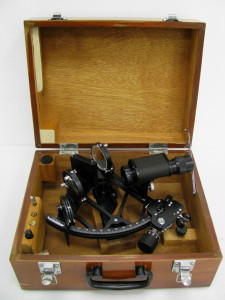 There is nothing quite so glorious to me as the ability to determine exactly where I am in the world by simply measuring the angle between the horizon and the sun or stars a couple of times a day. I have always wanted to know how to do that. And here was my chance. Actually, it is a U.S. Sailing requirement to be certified in Celestial Navigation before you can move on to the pinnacle of the U.S. Sailing series: Ocean Passage Making, which Rick and I planned to take in June.
There is nothing quite so glorious to me as the ability to determine exactly where I am in the world by simply measuring the angle between the horizon and the sun or stars a couple of times a day. I have always wanted to know how to do that. And here was my chance. Actually, it is a U.S. Sailing requirement to be certified in Celestial Navigation before you can move on to the pinnacle of the U.S. Sailing series: Ocean Passage Making, which Rick and I planned to take in June.
The textbook we were required to read in advance of the class, however, left me totally confused. Have you ever had the sense of reading and understanding all the individual words on a page, and yet having not the faintest clue about what it all said? My comprehension was zero. I went into the class as if entering a foreign land, with new rules and new tools and no idea how to apply them.
Thank goodness that the class was taught by a seasoned instructor who understood the material well beyond what we all needed to understand, who is patient and kind, who stepped through each phase of the learning process one by one, and who had prepared his own supplemental exercises, with answer sheets, so we could study on our own outside of class.
The math in Celestial Navigation has been reduced to nothing more than addition and subtraction, thanks to a number of tables in two reference books that incorporate the answers to all of the difficult math problems leading up to them. So the math is not the problem. The problem with celestial navigation, besides the obvious problem of trying to measure the angle of a celestial being to the horizon on a ship that is moving up and down, is that there are just so darn many steps! And while you can just follow through the steps without understanding why, it does help to limit errors if you know the conceptual need for each of the steps.
At first, I just took the homework home and started practicing, one step at a time, without understanding much at all. Then, it started to sink in. To know your latitude, you learn from the reference tables, how far north or south, the sun should be from the equator at the specific time of day and time of year, and then compare that to how far you are from the equator, using your sextant reading of the angle of the sun from the horizon, after applying a few other calculations to it. To know your longitude, you need to how how far the sun should be west of Greenwich at a specific time of day and time of year, based on the reference tables, and then compare that to where you are, also by using the sextant readings and a few other calculations added to it. You also need to know, approximately where you think you are, and you have to have the exact time you took your reading. Seconds matter. You actually have to make adjustments if your watch is slow or fast by even a few seconds, or if you sextant is off by just a fraction of a degree. And then you have to make an adjustment if you are reading where the bottom of the sun hits the horizon (“lower limb”) or the top of the sun.
The process is tedious and time consuming. The instructor said we should expect to study at least 14 hours between the two weekends, spread two weeks apart. I must have studied at least twice that. The final exam, which consisted of only five questions that included, I think, seven separate readings, took 6 hours to complete! Rick and I are proud to say, that out of the 10 students, all of whom were engineers except Rick and I, only six passed, and we were among them!
One of the better outcomes of having passed this class is that traditional coastal navigation seemed so much easier by comparison! We will need to keep our celestial navigation skills up because we will be bringing a sextant along in our travels, in the event that we loose all of our electronic equipment in an electrical storm or whatever. Just today, we finally won an Ebay auction on a used sextant, and it should be arriving shortly.
